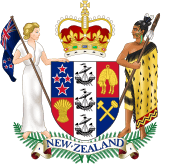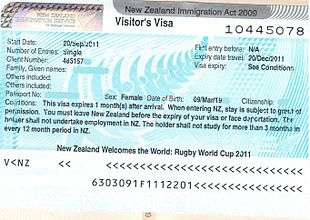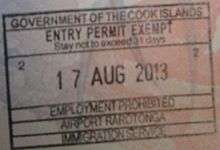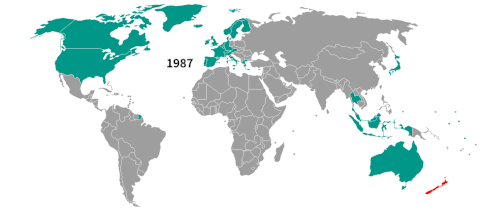Visa policy of New Zealand
Foreign nationals wishing to enter the Realm of New Zealand must obtain a visa unless they are
- a citizen or permanent resident of Australia or
- a citizen of one of the 60 visa waiver eligible countries and territories
- a holder of the United Nations laissez-passer or
- eligible for visa-free travel under other specific provisions (visiting force, cruise ship passengers and crew, aircraft crew, etc).
 |
|---|
| This article is part of a series on the politics and government of New Zealand |
| Constitution |
|
|
Executive government
|
|
52nd New Zealand Parliament
|
|
Elections
|
|
Judiciary
|
|
Local government
|
|
Foreign relations
|
|
Ideology
|
|
Related topics
|
|
Both citizens and permanent residents of Australia are deemed to hold resident status in New Zealand upon arrival under the Trans-Tasman travel arrangement.
Visitors must hold passports that are valid for at least 3 months beyond the period of intended stay. Visitors are required to hold proof of sufficient funds to cover their stay: NZD 1,000 per person per month of stay or NZD 400 if accommodation has been prepaid. Visitors are required to hold documents required for their next destination.[1]
New Zealand issues eVisas to nationals of visa waiver countries and China. Applications for student, work, and visitor visas can be lodged online.[2]
Visa policy map

Visa waiver countries and territories
Under the Immigration Act 2009[3] and the Immigration (Visa, Entry Permission, and Related Matters) Regulations 2010[4] passport holders of the following 60 jurisdictions may travel to New Zealand without obtaining a visa for up to 90 days.[5] A valid NZeTA must be held prior to travel.[6]
|
Holders of United Nations laissez-passer do not require a visa.
Purpose of the visit for all visa waiver countries must not be medical consultation or treatment
- Notes
- ^ British citizens and other British passport holders who produce evidence of the right to reside permanently in the United Kingdom may travel to New Zealand without visa for 180 days.
- ^ A visa waiver does not apply to people travelling on alien's (non-citizen's) passports issued by these countries – Estonia, Latvia and Lithuania.
- ^ Only Greek passport holders whose passports were issued on and after 1 January 2006.
- ^ Portuguese passport holders must also have the right to live permanently in Portugal.
- ^ Residents of Hong Kong travelling on Hong Kong Special Administrative Region passport or British National (Overseas) passport.
- ^ Residents of Macau travelling on Macau Special Administrative Region passport.
- ^ Permanent residents with the right of abode in Taiwan will have Personal Identification Number printed in Taiwan passports.
- ^ Including nationals of the USA.
| Date of visa changes |
|---|
Cancelled: |
Other categories



Additionally, a visa waiver applies to the following categories:[49]
- people granted a visa waiver by special direction.
- members of a visiting force (including members of the civilian component of the visiting force) as defined in the Visiting Forces Act 2004 at the request or with consent of the Government of New Zealand and in the ordinary course of the person's duty or employment.
- for periods of 28 days, crew or passengers on any ship carrying passengers (including cruise ship passengers) or cargo or both (in the ordinary course of business of the craft) between any foreign port and New Zealand.
- for periods of 28 days, crew on any foreign ship authorised by the Minister of Transport to carry coastal cargo.
- for periods of 7 days, beginning with the day on which the aircraft arrived in New Zealand, aircraft crew on any commercial aircraft flying between any other country and New Zealand.
- members of, or any person associated with, any scientific programme or expedition under the auspices of a Contracting Party to the Antarctic Treaty within the meaning of the Antarctica Act 1960.
- any other class of persons specified in the Immigration (Visa, Entry Permission, and Related Matters) Regulations 2010.
NZeTA
Since 1 October 2019, visitors from visa waiver countries must request a New Zealand Electronic Travel Authority (NZeTA) prior to travel.[50] The NZeTA is mandatory for all sea and air arrivals, including transit, except for citizens of Australia. When issued, it remains valid for the period of two years.[51] NZeTA is priced at NZD 9 or NZD 12 depending on whether the applicant applies through a mobile app or online.[52]
The New Zealand government expects the NZeTA to cause visitor numbers to drop and reduce visitor spending by NZD 51 million.[53]
IVL
Since July 2019, international visitors requiring a visa or NZeTA to enter New Zealand (except citizens or residents of entities listed in table below) have to pay a NZD 35 International Visitor Conservation and Tourism Levy (IVL) that will be valid for the duration of their visa/NZeTA.[54]
Unacceptable travel documents
Nationals of Somalia may not travel to New Zealand using a Somali passport. Instead, visa is affixed to a New Zealand Certificate of Identity. Other unacceptable documents for travel to New Zealand include Tongan Protected Person's passports, investor passports issued by Kiribati and Nauru, collective passports issued by Slovenia, Northern Cypriot passport, diplomatic and official passports issued by Taiwan, Article 17 Kuwaiti passport, Iraqi S series passport and Egyptian travel documents issued for Palestinian refugees without a reentry visa for Egypt. [55]
APEC Business Travel Card
Holders of passports issued by the following countries who possess an APEC Business Travel Card (ABTC) with the "NZL" code on the reverse that denotes it is valid for travel to New Zealand can enter visa-free for business trips for up to 90 days.[56]
ABTCs are issued to nationals of:[57]
Transit

Eligible passengers who are transiting through Auckland Airport for less than 24 hours, and not leaving the transit area of the airport, do not need a transit visa. Eligible passengers are:[58]
- visa-waiver country citizens
- all passengers whose next legal destination is Australia
- citizens of one of the following countries, which are exempt from transit visa requirements:[59]
Cook Islands

All visitors to the Cook Islands, irrespective of nationality, are visa-exempt for a maximum stay of 31 days. Visitors travelling for tourist purposes may extend their stay, for periods of 31 days, up to a maximum of 6 months.[60]
Niue
.png)
Visas are required for all visitors to Niue, except for nationals of New Zealand who are Niueans or descendants of Niueans and nationals of other countries who are bona fide visitors staying 30 days or less. Visitors must have sufficient funds for the length of their stay together with a confirmed reservation for accommodation and those not holding return or onward tickets could be refused entry. Extensions of stay are possible.[61][62]
Tokelau
All visitors must obtain a permit to enter Tokelau from the Tokelau Apia Liaison Office in Apia, at least 2 weeks prior to travel. Tokelau can only be reached by boat from Samoa and a permit from the Samoan Immigration Authorities is required to leave and re-enter Samoa.[63]
Statistics
New Zealand issued 262,033 general visitor visas in the 2016/17 fiscal year. Top nationalities were:[64]
| Applicant nationality | Number of general visitor visas issued |
|---|---|
| 183,692 | |
| 45,906 | |
| 14,378 | |
| 13,511 | |
| 17,730 | |
| 15,074 | |
| 11,232 | |
| 10,216 | |
| 9,918 | |
| 9,438 | |
| 5,036 |
Most visitors came from the following countries of residence:[65]
| Country | 2012 | 2013 | 2014 | 2015 | 2016 | 2017 | Change (%) 2016-17 | 2018 |
|---|---|---|---|---|---|---|---|---|
| 1,155,792 | 1,218,016 | 1,247,760 | 1,326,800 | 1,409,200 | 1,472,160 | 1,494,541 | ||
| 197,024 | 228,928 | 264,864 | 355,904 | 409,008 | 417,872 | 448,189 | ||
| 177,680 | 201,424 | 220,512 | 243,104 | 291,392 | 330,128 | 352,074 | ||
| 189,648 | 191,632 | 194,416 | 203,952 | 220,976 | 249,264 | 237,166 | ||
| 63,776 | 69,808 | 78,912 | 84,544 | 96,848 | 104,864 | 102,087 | ||
| 72,080 | 74,560 | 81,136 | 87,328 | 100,736 | 102,048 | 99,784 | ||
| 52,896 | 50,992 | 55,488 | 64,992 | 82,384 | 91,168 | 87,853 | ||
| 46,448 | 48,192 | 48,800 | 52,352 | 59,760 | 67,280 | 71,261 | ||
| 29,856 | 30,976 | 37,392 | 46,000 | 52,016 | 61,440 | 67,953 | ||
| 36,400 | 42,256 | 46,848 | 49,584 | 57,344 | 58,544 | 61,464 | ||
| 26,272 | 28,080 | 31,456 | 36,288 | 44,768 | 54,688 | 58,763 | ||
| 29,424 | 28,976 | 31,536 | 34,240 | 51,792 | 53,840 | 56,430 | ||
| Other countries | 487,322 | 503,855 | 518,280 | 546,839 | 623,715 | 670,411 | ||
| Total | 2,564,618 | 2,717,695 | 2,857,400 | 3,131,927 | 3,499,939 | 3,733,707 | 3,863,217 |
History
Before 1881
In the early years New Zealand was seen by Europeans as the most remote country on earth. For most Europeans New Zealand was an unappealing prospect, a strange and lonely land reached after 100 days on dangerous seas; its coasts were thought treacherous, its inhabitants bloodthirsty. Only exceptional reasons led people to set off for such a distant corner of the globe. Many of New Zealand's early immigrants first spent time in Australia, and most of them were only temporary visitors in search of items to trade.
Among the earliest visitors were sealers, attracted by the promise of high-quality oil, and fur for hats (often sold in China in return for tea). As early as 1792, whalers came to the northern end of the country, also as temporary visitors. Also missionaries arrived in New Zealand. By 1839 the total non-Māori population was about 2,000.
Until 1839 there were only about 2,000 immigrants in New Zealand; by 1852 there were about 28,000. The decisive moment for this remarkable change was 1840. In that year, the Treaty of Waitangi was signed. This established British authority in European eyes, and gave British immigrants legal rights as citizens. Most of the people who moved to New Zealand Company settlements were British.
From 1853 to 1870 the non-Māori population of New Zealand rose from just under 30,000 to over 250,000. As with the inflow of the 1840s, there were three main groups – assisted families coming directly from Britain; individuals from across the Tasman Sea looking for a better life; and military settlers.[66]
1881–1914
Restrictions on immigration were first imposed in 1881. Until then, anyone who arrived in New Zealand had been able to remain in the country.
The Chinese Immigrants Act 1881 was the first to restrict the entry of a specific group of people. The number of Chinese who could arrive on one ship was limited to one for every 10 tons of the vessel's weight. A poll tax of £10 was also imposed on each Chinese person entering the country. Unlike the Chinese, most Indians were British subjects and free to enter New Zealand until the very end of the 19th century. From 1896, despite objections from the British government, New Zealand tried to pass more comprehensive legislation restricting the immigration not just of the Chinese but also of Indians and other Asians.
The 1899 act prohibited the entry of immigrants who were not of British or Irish parentage and who could not fill in an application form 'in any European language' – which in practice meant English. These rules were in place for the next 20 years. The fear of economic competition was one reason why the entry of Chinese, Indians and other 'race aliens' was restricted.
1914–1945
Under the War Regulations of 1916, during the First World War, no person over the age of 15 could land in New Zealand without a passport or other document establishing his or her nationality or identity.
Under the Undesirable Immigrants Exclusion Act 1919, Germans and Austro-Hungarians were prohibited from entering without a licence issued by the attorney general. The act also gave power to the attorney general to prohibit the entry of any person not resident in New Zealand – including British subjects – who was disaffected or disloyal, or of such a character that his presence would be injurious to the peace, order and good government' of New Zealand.
The Immigration Restriction Amendment Act 1920 was passed primarily to restrict possible Asian immigration, but Asians were not its only targets. It was also used to curb the entry of other non-British people, particularly southern Europeans such as Dalmatians and Italians.
The 1931 Immigration Restriction Amendment Act, passed during the Depression period of the 1930s, prevented aliens (as non-British immigrants were still known) from Europe entering New Zealand. The only exceptions were if they had guaranteed employment, a considerable amount of capital, or knowledge and skills.
After 1945

From 1961 only Australians had unrestricted entry to New Zealand. This was a long-standing right, established in 1840 when New Zealand became a British colony like Australia. Reciprocal travel arrangements, beginning in the 1920s, formalised this free movement from one country to the other. In 1973, the Trans-Tasman Travel Arrangement allowed Australian and New Zealand citizens to enter each other's countries to visit, live, work, or remain indefinitely without having to apply for a permit.
Under the 1961 Immigration Amendment Act, British and Irish immigrants, along with other non-New Zealand citizens (except Australians, who could enter freely) were required to have a permit before entering New Zealand. In practice, the permit was only a formality for Britons and Irish; they were issued with permits on arrival. Nevertheless, for the first time, the 1961 act put British and non-British people on the same footing when they sought to enter New Zealand. After the immigration policy review of 1974, British migrants, like all others, were required to obtain a permit before they left their homelands. The British and Irish were now on the same footing as the nationals of other countries.
Between the 1940s and the 1970s, New Zealand concluded visa-free agreements with countries of Western Europe.
Visa-free access for citizens of Fiji, Kiribati, Nauru, Tuvalu, Indonesia, Thailand, Zimbabwe, Samoa, South Africa and Tonga has been cancelled because of illegal immigration.
As of 2017, under the Immigration Act 2009[3] and the Immigration (Visa, Entry Permission, and Related Matters) Regulations 2010[4] passport holders of the 60 jurisdictions may travel to New Zealand without obtaining a visa for up to 90 days.[5]
See also
| Wikivoyage has a travel guide for Cook Islands. |
| Wikivoyage has a travel guide for New Zealand. |
| Wikivoyage has a travel guide for Niue. |
| Wikivoyage has a travel guide for Tokelau. |
- Visa requirements for New Zealand citizens
- Trans-Tasman travel arrangement
References
- "Country information (visa section)". Timatic. International Air Transport Association (IATA) through Olympic Air. Retrieved 1 April 2017.
- "eVisas - Immigration New Zealand". www.immigration.govt.nz. Retrieved 11 April 2018.
- "Immigration Act 2009 No 51 (as at 26 November 2018), Public Act – New Zealand Legislation". www.legislation.govt.nz. Retrieved 2 July 2019.
- "Immigration (Visa, Entry Permission, and Related Matters) Regulations 2010 (SR 2010/241) (as at 08 May 2017) – New Zealand Legislation". www.legislation.govt.nz. Retrieved 11 April 2018.
- Immigration New Zealand Visa-Waiver Countries, Immigration New Zealand (INZ) – Ministry of Business, Innovation and Employment
- "Information about NZeTA". Immigration New Zealand.
- Exchange of Notes between New Zealand and France establishing Visa Abolition Agreement, 22 November 1947, retrieved 25 June 2017
- "New Zealand Treaties Online - Details". www.treaties.mfat.govt.nz. Retrieved 11 April 2018.
- "New Zealand Treaties Online - Details". www.treaties.mfat.govt.nz. Retrieved 11 April 2018.
- "UK Treaties Online". treaties.fco.gov.uk. Retrieved 11 April 2018.
- "New Zealand Treaties Online - Details". www.treaties.mfat.govt.nz. Retrieved 11 April 2018.
- "New Zealand Treaties Online - Details". www.treaties.mfat.govt.nz. Retrieved 11 April 2018.
- "New Zealand Treaties Online - Details". www.treaties.mfat.govt.nz. Retrieved 11 April 2018.
- "New Zealand Treaties Online - Details". www.treaties.mfat.govt.nz. Retrieved 11 April 2018.
- "New Zealand Treaties Online - Details". www.treaties.mfat.govt.nz. Retrieved 11 April 2018.
- "New Zealand Treaties Online - Details". www.treaties.mfat.govt.nz. Retrieved 11 April 2018.
- "一部旅券査証及び査証料の相互免除に関する日本国政府とニュー・ジーランド政府との間の交換公文" (PDF). Ministry of Foreign Affairs of Japan. 15 June 1970. Retrieved 14 February 2018.
- "New Zealand Treaties Online - Details". www.treaties.mfat.govt.nz. Retrieved 11 April 2018.
- "New Zealand Treaties Online - Details". www.treaties.mfat.govt.nz. Retrieved 11 April 2018.
- "New Zealand Treaties Online - Details". www.treaties.mfat.govt.nz. Retrieved 11 April 2018.
- Having the right of permanent residence in Portugal
- "Immigration Regulations 1987". www.nzlii.org. Retrieved 11 April 2018.
- "Immigration Regulations 1991 Amendment No. 2 1993". www.nzlii.org. Retrieved 11 April 2018.
- "Immigration Regulations 1991 Amendment No. 5 1995". www.nzlii.org. Retrieved 11 April 2018.
- "Immigration Amendment Regulations (No. 2) 1998". www.nzlii.org. Retrieved 11 April 2018.
- "Immigration Amendment Regulations (No. 3) 1998". www.nzlii.org. Retrieved 11 April 2018.
- "Immigration Amendment Regulations (No. 4) 1998". www.nzlii.org. Retrieved 11 April 2018.
- "Immigration Amendment Regulations (No. 5) 1998". www.nzlii.org. Retrieved 11 April 2018.
- "Immigration Amendment Regulations (No. 2) 1999". www.nzlii.org. Retrieved 11 April 2018.
- Immigration Amendment Regulations (No 6) 1999, 11 November 1999, retrieved 25 June 2017
- Immigration Amendment Regulations (No 2) 2000, 2 November 2000, retrieved 25 June 2017
- Immigration Amendment Regulations (No 3) 2001, 30 August 2001, retrieved 25 June 2017
- Immigration Amendment Regulations (No 2) 2002, 18 December 2002, retrieved 25 June 2017
- IImmigration Amendment Regulations 2005, 17 March 2005, retrieved 25 June 2017
- Immigration Amendment Regulations (No 2) 2007, 21 June 2007, retrieved 25 June 2017
- Immigration Amendment Regulations (No 2) 2009, 23 November 2009, retrieved 27 July 2017
- Immigration (Visa, Entry Permission, and Related Matters) Amendment Regulations (No 2) 2013, 30 May 2013, retrieved 25 June 2017
- Immigration (Visa, Entry Permission, and Related Matters) Amendment Regulations (No 2) 2014, 29 May 2014, retrieved 25 June 2017
- Immigration (Visa, Entry Permission, and Related Matters) Amendment Regulations 2016, 20 October 2016, retrieved 25 June 2017
- Exchange of Notes between the Government of New Zealand and the Government of the Kingdom of Tonga constituting an Agreement on the Waiver of Visas,
Exchange of Letters between the Government of New Zealand and the Government of Fiji constituting an Agreement on the Waiver of Visas. - Taonga, New Zealand Ministry for Culture and Heritage Te Manatu. "2. – Pacific Islands and New Zealand – Te Ara Encyclopedia of New Zealand". teara.govt.nz. Retrieved 11 April 2018.
- Was applied from 1 November 1987
- Was applied from 1 October 1996. Immigration Regulations 1991 Amendment No. 7 1996,
Immigration Amendment Regulations (No 3) 2000, 7 December 2000, retrieved 25 June 2017. - Was applied from 1 November 1987. Immigration Amendment Regulations (No 3) 2000, 7 December 2000, retrieved 25 June 2017
- Was applied from 1 March 2000.
Immigration Amendment Regulations (No 6) 1999, 11 November 1999, retrieved 25 June 2017,
Immigration Amendment Regulations 2003, 20 February 2003, retrieved 25 June 2017. - Exchange of Letters between the Government of New Zealand and the Government of Kiribati constituting an Agreement on the Waiver of Visas,
Exchange of Letters between the Government of New Zealand and the Governemt of Nauru constituting an Agreement on the Waiver of Visas,
Exchange of Letters between the Government of New Zealand and the Government of Tuvalu constituting an Agreement on the Waiver of Visas.
Immigration Amendment Regulations (No 4) 2003, 4 December 2003, retrieved 25 June 2017 - Was applied from 1 October 1996. Immigration Regulations 1991 Amendment No. 7 1996, Immigration (Visa, Entry Permission, and Related Matters) Amendment Regulations 2016, 20 October 2016, retrieved 25 June 2017.
- "E2.1 People to whom a visa waiver applies". www.immigration.govt.nz. Retrieved 11 April 2018.
- Government confirms Electronic Travel Authority details
- "Electronic Travel Authority | Immigration New Zealand". www.immigration.govt.nz. Retrieved 2 July 2019.
- "New border security system will cost $14m to run and could cause travel chaos". Stuff. Retrieved 1 July 2019.
- "New border security system will cost $14m to run and could cause travel chaos". Stuff. Retrieved 10 September 2019.
- "Paying the International Visitor Conservation and Tourism Levy | Immigration New Zealand". www.immigration.govt.nz. Retrieved 2 July 2019.
- "Operational Manual - Immigration New Zealand. Issue Date: 1 July 2019Operational Manual - Immigration New Zealand. Issue Date: 22 August 2016". www.immigration.govt.nz. Retrieved 3 October 2019.
- "ABTC Summary - APEC Business Travel Card". travel.apec.org. Archived from the original on 19 October 2016. Retrieved 11 April 2018.
- "Visit New Zealand - Immigration New Zealand". www.immigration.govt.nz. Retrieved 11 April 2018.
- "N2.5 Transit visa country waiver list". www.immigration.govt.nz. Retrieved 11 April 2018.
- Visas and immigration, Discover Cook Islands.
- "Archived copy". Archived from the original on 15 March 2014. Retrieved 15 March 2014.CS1 maint: archived copy as title (link)
- Immigration New Zealand statistics – V1 – Visitor applications decided
- "International Visitor Arrivals to New Zealand: December 2015 Page 11" (PDF). stats.govt.nz. Retrieved 11 April 2018.
- Taonga, New Zealand Ministry for Culture and Heritage Te Manatu. "Te Ara The Encyclopedia of New Zealand". www.teara.govt.nz. Retrieved 11 April 2018.